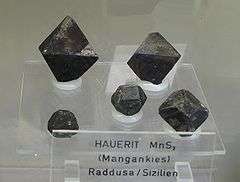Hauerite
| Hauerite | |
|---|---|
|
| |
| General | |
| Category | Sulfide mineral, pyrite group |
| Formula (repeating unit) | MnS2 |
| Strunz classification | 2.EB.05a |
| Crystal system | Cubic |
| Crystal class |
Diploidal (m3) H–M Symbol: (2/m 3) |
| Space group | Pa3 |
| Unit cell | a = 6.107 Å; Z = 4 |
| Identification | |
| Formula mass | 119.07 g/mol |
| Color | Reddish brown or brownish black |
| Crystal habit | Octahedral crystals and globular aggregates |
| Cleavage | {100} Perfect, {010} Perfect, Perfect on {001} |
| Fracture | Uneven to subconchoidal |
| Tenacity | Brittle |
| Mohs scale hardness | 4 |
| Luster | Metallic-adamantine |
| Streak | Reddish brown |
| Diaphaneity | Opaque to subtranslucent |
| Specific gravity | 3.463 |
| Optical properties | Isotropic |
| Refractive index | n = 2.69 |
| References | [1][2][3] |
Hauerite is a manganese sulfide mineral with the chemical formula MnS2. It forms reddish brown or black octahedral crystals with the pyrite structure and it is usually found associated with the sulfides of other transition metals such as rambergite. It occurs in low temperature, sulfur rich environments associated with solfataras and salt deposits in association with native sulfur, realgar, gypsum and calcite.[1]
It was discovered in Austro-Hungarian Monarchy near Banska Bystrica in what is now Slovakia in 1846 and named after the Austrian geologists, Joseph Ritter von Hauer (1778–1863) and Franz Ritter von Hauer (1822–1899).[1][3]
Under high pressure conditions (P>11 GPa), Hauerite undergoes a large collapse in unit cell volume (22 %) driven by a spin-state transition.[4]
References
| Wikimedia Commons has media related to Hauerite. |
